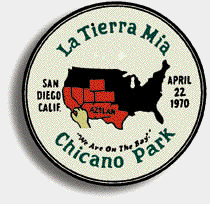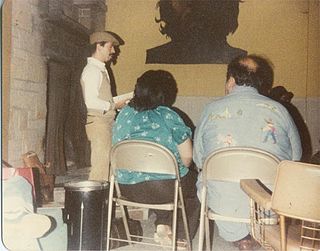
The San Diego–Coronado Bridge, locally referred to as the Coronado Bridge, is a prestressed concrete/steel girder bridge, crossing over San Diego Bay in the United States, linking San Diego with Coronado, California. The bridge is signed as part of State Route 75.
The Royal Chicano Air Force (RCAF) is a Sacramento, California-based art collective, founded in 1970 by Ricardo Favela, José Montoya and Esteban Villa. It was one of the "most important collective artist groups" in the Chicano art movement in California during the 1970s and the 1980s and continues to be influential into the 21st century.

Chicano Park is a 32,000 square meter park located beneath the San Diego-Coronado Bridge in Barrio Logan, a predominantly Chicano or Mexican American and Mexican-migrant community in central San Diego, California. The park is home to the country's largest collection of outdoor murals, as well as various sculptures, earthworks, and an architectural piece dedicated to the cultural heritage of the community. Because of the magnitude and historical significance of the murals, the park was designated an official historic site by the San Diego Historical Site Board in 1980, and its murals were officially recognized as public art by the San Diego Public Advisory Board in 1987. The park was listed on the National Register of Historic Places in 2013 owing to its association with the Chicano Movement, and was designated a National Historic Landmark in 2016. Chicano Park, like Berkeley's People's Park, was the result of a militant people's land takeover. Every year on April 22, the community celebrates the anniversary of the park's takeover with a celebration called Chicano Park Day.

Barrio Logan is a neighborhood in south central San Diego, California. It is bordered by the neighborhoods of East Village and Logan Heights to the north, Shelltown and Southcrest to the east, San Diego Bay to the southwest, and National City to the southeast. Interstate 5 forms the northeastern boundary. The Barrio Logan Community Plan Area comprises approximately 1,000 acres, of which slightly more than half is under the jurisdiction of the Port of San Diego or the United States Navy rather than the city of San Diego. The community is subject to the California Coastal Act. Though located near the City's Central core, it has long been considered part of Southeast San Diego by many locals, being directly Southeast of Downtown, and with previous historical records labeling it as part of "Western Southeast San Diego."

The Centro Cultural de la Raza is a non-profit organization with the specific mission to create, preserve, promote and educate about Chicano, Mexicano, Native American and Latino art and culture. It is located in Balboa Park in San Diego, California.The cultural center supports and encourages the creative expression “of the indigenous cultures of the Americas.” It is currently a member of the American Alliance of Museums.

Alberto Baltazar Urista Heredia, better known by his nom de plume Alurista, is a Chicano poet and activist.

The Ford Building, a Streamline Moderne structure in Balboa Park, San Diego, California, serves as the home of the San Diego Air & Space Museum. The building was originally built by the Ford Motor Company for the California Pacific International Exposition, which was held in 1935 and 1936. In the middle of the museum the Ford's Hall is used for weddings, balls, parties, and other occasions.

Southeast San Diego refers to the southeastern portion of the City of San Diego and the neighborhoods south of State Route 94 and east of Downtown San Diego. There are three official community planning areas: Skyline-Paradise Hills, Encanto Neighborhoods, and Southeastern.
Nova Color Artists Acrylic Paint was first manufactured in Culver City, California in 1965 shortly after the commercial introduction of acrylic polymer resin for paint production. Mexican immigrant Carlos Amparan developed a line of brilliantly colored fine art acrylic paint after experimenting with this relatively new water-borne emulsion. He and his brother Raoul began small-scale production of Nova Color and sold it at a low price to local artists.

The Chicano Art Movement represents groundbreaking movements by Mexican-American artists to establish a unique artistic identity in the United States. Much of the art and the artists creating Chicano Art were heavily influenced by Chicano Movement which began in the 1960s.

Xavier Guerrero was one of the pioneers of the Mexican muralism movement in the early 20th century. He learned painting working with his father, who worked in masonry and decorating, with evidence that his ability was mostly self-taught. In 1912, he moved to Guadalajara and began painting murals, moving to Mexico City in 1919 just as the muralism movement was about to begin. Most of his work was in collaboration with or subordinate to other painters such as Diego Rivera and David Alfaro Siqueiros, working at the San Ildefonso College, the Secretaría de Educación Pública building and the Universidad Autónoma de Chapingo; however, much of his other work has been lost. While best known for his mural work, his later canvas work is considered to be better.
Juana Alicia is an American muralist, printmaker, educator, activist and, painter. She has been an educator for forty years. Juana Alicia, as part of the faculty Berkeley City College, founded and directed the True Colors Public Art program. Her sculptures and murals are principally located in the San Francisco Bay Area, Nicaragua, Mexico, Pennsylvania, and in many parts of California.

Roberto Chavez is an American artist. known for his personally symbolic portraits, public murals and "funny-grotesque" paintings that reflect the multicultural landscape of Los Angeles. He was recently included in the Getty Center's Pacific Standard Time: Art in L.A., 1945-1980 and the Smithsonian’s Our America: The Latino Presence in American Art exhibits.
Guillermo Acevedo (1920-1988) was a Peruvian-born artist and master draftsman, most famous in the United States for his striking portrayal of Native Americans of the Southwest, and for his ability to capture and help preserve the disappearing architectural styles of old neighborhoods throughout the U.S. and abroad. Known to be an artist-observer with great sensitivity, Acevedo is recognized as a master at recording the human condition.
Victor Ochoa is an activist, painter, graphic designer and master muralist. He has painted over 100 murals, many of them in San Diego, California. He is considered one of the pioneers of San Diego's Chicano art movement. Ochoa was one of the original activists at Chicano Park and a co-founder of Centro Cultural de la Raza in Balboa Park, both in San Diego. He helped establish the influential Border Art Workshop/Taller de Arte Fronteriza (BAW/TAF). Ochoa is also a teacher of art and Chicano heritage. His work has been shown nationally and internationally, including at the Venice Bi-Annual, at the Museum of Contemporary Art, San Diego and in the groundbreaking exhibition, Chicano Art: Resistance and Affirmation (CARA). In addition to creating his own work, he is also a master of art preservation techniques, especially relating to murals. He is considered to be a "serious cultural resource in the border region.
Josephine "Josie" Talamantez is a historian from San Diego, California. She co-founded Chicano Park in 1970 and helped develop it into a cultural National Historic Landmark containing the largest collection of artistic murals in the United States. Talamantez was also the Chief of Programs for the California Arts Council, served as the director of the Centro Cultural de la Raza, and was on the board of the National Association of Latino Arts and Culture.
Irma Patricia Aguayo, also known as Patricia Aguayo, is a Chicano Park muralist and longtime activist. She was born and raised in San Diego, California. Both of her parents are from Mexico and she grew up in a Mexican culture household but was told by her parents that in order to succeed in America to act American outside her house. It was in middle school after meeting with her counselor, Ms. Barrios, where she first heard someone of Mexican descent call themselves Chicana that Aguayo realized that she also identified as Chicana. After researching Chicana artists, she realized that there weren't a lot of artists. So she decided that she would create her own artwork.
A Mexican American is a resident of the United States who is of Mexican descent. Mexican American-related topics include the following:

Mission Cultural Center for Latino Arts (MCCLA) is an arts nonprofit that was founded in 1977, and is located at 2868 Mission Street in the Mission District in San Francisco, California. They provide art studio space, art classes, an art gallery, and a theater. Their graphics department is called Mission Grafica, and features at studio for printmaking and is known for the hand printed posters.
Carmen Linares-Kalo is a Chicana mural artist and fourth-generation fourth-generation spiritualist and practitioner of the Uto Nahua Mexica/Aztec traditions. She is based in San Diego and most known for her work on a mural located in Chicano Park in honor of the Kumeyaay people.











